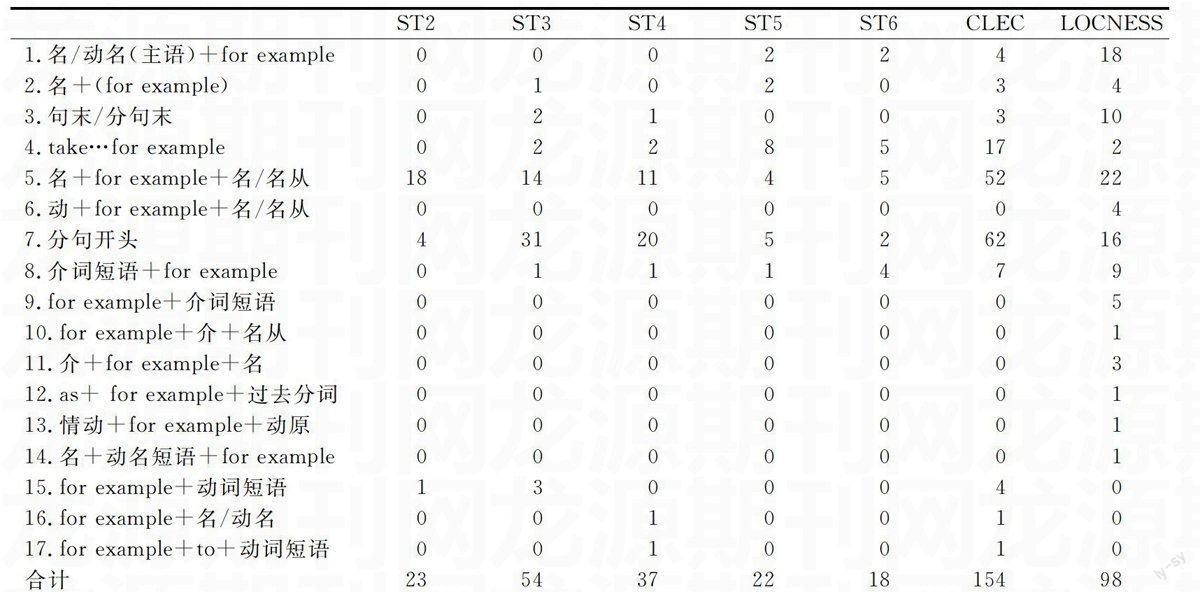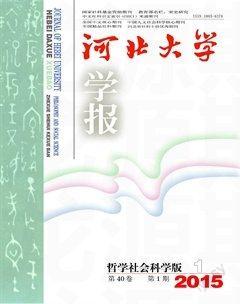基于语料库的学习者例证词“for example”对比研究
郭书彩 李娜 徐瑞华



摘要:基于英美大學生作文语料库(LOCNESS)和中国英语学习者语料库(CLEC)调查中国英语学习者在写作中使用例证词“for example”的特点,研究发现,中国英语学习者无论在使用频数还是在用法上都具有明显区别于本族语者的特征。
关键词:语料库,例证词,for example, LOCNESS,CLEC
中图分类号: K26文献标识码:A 文章编号:1005-6378(2015)01-0103-06
DOI:10.3969/j.issn.1005-6378.2015.01.020
一、引言
近年来许多基于语料库的研究表明,自然语言中存在大量重复出现的多词组合。Sinclair[1]因此提出了组织语言的两个原则:习语原则(idiom principle)和自由选择原则(open choice principle)。前者指语言中业已存在大量半预制短语,虽然这些短语看起来可以进一步分解,但它们被作为一个整体来使用。后者指根据语法规则创造新的表达方式。Sinclair认为,在组织文本时,习语原则优先,自由选择原则只是适时使用[1]114。
Biber et al.[2]、Biber[3]和Simpson-Vlach & Ellis[4]等多项研究表明,学术英语中存在许多重复出现的多词组合,如it should be noted that,as a result of,in addition,on the other hand,the extent to which,take a look at,for example,in the case of等。这些组合被冠以不同的名称,如词汇短语(lexical phrases)、公式语(formulas)、词块(lexical chunks)、词串(lexical bundles)、固定表达(fixed expressions)、预制语块(prefabs)等。它们兼具语义和句法特征,在学术写作中经常被用来引入话题、表明观点、阐述观点、举例说明、比较对照、概括总结等。就英语学习者来说,恰当使用这些多词组合能够提高语言表达的流利性[5-6]、准确性[7]和地道性[8-10]。
基于本族语者语料库和学习者语料库的对比研究表明,在使用这些多词组合时,学习者经常出现超用或少用现象。Paquote[11]参照LOCNESS语料库,调查了国际学习者英语语料库(ICLE)的五个子语料库(学习者母语分别是荷兰语、法语、德语、波兰语和西班牙语)中用以举例的多词组合的使用情况以及母语对此的影响。这些多词组合包括:类似于固定词组的for example和for instance;由名词example、动词illustrate和动词exemplify组成的搭配和结构,如an example of this is,this is a prime example of, is illustrated by。研究表明,各母语背景的学习者群体都过多使用for example和for instance两个固定词组,但过少使用由example、illustrate和exemplify组成的用以举例的多词组合。研究同时表明了母语对学习者习得这些多词组合的影响。
对英语学习者来说,举例是一个非常重要且经常使用的修辞功能。在多年的英语教学中,笔者
发现学习者在举例时最常使用的多词组合是for example,但经常出现误用现象。为进一步调查学习者使用for example的情况,本研究以英语本族语者语料为参照,调查不同层次的中国学习者使用for example的特点。
二、研究设计
1. 研究问题
本研究试图回答以下三个问题:(1)中国英语学习者和英语本族语者使用for example的频数有何异同?主要影响因素有哪些?(2)中国英语学习者和英语本族语者使用for example的用法有何异同?(3)不同层次的中国英语学习者使用for example的频数和用法有何异同异?
2. 语料库和工具
本研究使用的语料库是中国学习者英语语料库CLEC[12]中的5 个子库ST2、ST3、ST4、ST5 和ST6,分别代表高中、非英语专业低年级、非英语专业高年级、英语专业低年级、英语专业高年级学习者英语。各子库的语料题材相近,库容分别为208 088、209 043、212 855、214 510、226 106,总计1070 602词次。本研究使用的参照语料库是英美大学生作文语料库LOCNESS,库容为324 304词次,使用的检索工具是AntConc3.2.2。
3.研究步骤
主要研究步骤如下:
(1)用AntConc3.2.2检索for example在CLEC五个子库和LOCNESS中的原始频数,计算for example在10万词中出现的标准频数。
(2)以for example为节点词,从CLEC五个子库和LOCNESS中提取相应的索引行。在语境中对索引行中for example的用法逐一进行分析、归类和标注。
(3)对CLEC五个子库和LOCNESS中for example的各种用法进行统计和比较。
河北大学学报(哲学社会科学版)2015年第1期三、研究结果和分析
1.学习者和本族语者使用for example的频数
如表1所示,中国英语学习者和英语本族语者使用for example的频数存在明显差异。在CLEC的五个子库中,for example共出现883次,每10万词出现的标准频数是82.48。而LOCNESS中for example共出现174次,每10万词出现的标准频数是53.65次。总体而言,与英语本族语者相比,中国英语学习者明显过多使用for example。但是对CLEC五个子库的数据进行对比后发现,非英语专业大学生的使用频率最高,ST3和ST4中for example的原始频数分别319和322,标准频数分别为152.60和151.28,几乎是LOCNESS中标准频数53.65的3倍。而高中生(ST2)、英语专业低年级(ST5)和高年级的标准频数分别是42.77、31.23和38.04,均明显低于LOCNESS中的标准频数。
表1CLEC和LOCNECC中for example的频数
ST2中的标准频数低于LOCNESS中标准频数的一个原因可能与作文体裁不同有关,议论文中经常使用举例论证,而记叙文中很少使用。LOCNESS中绝大多数作文是议论文,因此语料中for example出现频率较高。而CLEC中高中生作文体裁划分不明显,正如桂诗春、杨慧中所说,“他们所写的往往就是他们要说的话”[12]4,故for example的出现频率较低。而ST3和ST4标准频数远远高于LOCNESS标准频数的一个主要原因可能是ST3和ST4主要是以议论文为主的试卷作文,在考试状态下,学习者没有过多地时间思考,会更倾向于使用少数惯常的固定表达。另一个原因是许多非英语专业大学生为了应付考试,会死记硬背一些程式化的表达。第三个原因可能是学习者还没有掌握用以举例的其他表达法,如a prime example of this is, a case in point is等,故语料中for example的出现频率奇高。ST5和ST6中的标准频数低于LOCNESS标准频数的主要原因可能是语料来源是自由作文,作文体裁各式各样,不像LOCNESS语料那样以议论文为主。
2.学习者和本族语者for example用法差异
(1)for example用于句首和非句首的分布
从表2可以看出,中国英语学习者和英语本族语者将for example用于句首和非句首的比例存在巨大差异。LOCNESS语料库中,高达563%的for example用于非句首,只有43.7%用于句首。而CLEC正好相反,高达82.6%用于句首,只有17.4%用于非句首。CLEC所有五个子库中for example用于句首的比例均明显高于用于非句首的比例,ST3和ST4甚至高达83%和885%。就连五个子库中该比例最低的ST5也有67.2%的for example用于句首。这是中国英语学习者英语区别于本族语者英语的一个重要特征。
从表3可以看出,LOCNESS语料库中for example用于句首时,只有两种用法,97.37%的情况下后跟完整句,只有2例后跟名詞短语,而且其中之一位于括号内:
例1:For example, the high yield crops; they do indeed give many times the harvest of a normal variety yet several leach the soil, require very careful use of oil based fertilizers and countless other minor adjustments.
例2:Thus, when serious criminal cases occur, and the state that they occur in does not have the death penalty, a debate occurs over it necessity. (For example, the Jeffrey Dahmer case)
而CLEC中,除了LOCNESS中的两种用法,还有其他四种用法——for example 后分别跟动名词短语、动词短语、介词短语、不定式短语。高中英语学习者错误类型最多,频数也最高,只有606%的for example后跟完整句,与本族语者的差距最明显。
例3:However I can have some time to spend in doing something that I like. For example reading some novel and listening to the radio. (ST2)
例4:…during have…during these days, many classmates give up doing others thing. For example: give up watching TV, playing football, or shopping. (ST2)
例5:So, In my opinion, the more practice, the more perfect you get. For example, in the course of learning English. We have …during have…(ST3)
例6:If we save the money from those patients who are beyone hope, we can use the money in other ways. For example, to invest more money to backward mountain areas and help people get rid of poverty. (ST6)
以上例句中都是for example的错误用法。For example用于句首,首字母大写,但其后跟的不是一个完整句,而是句子片段。说明学生没有掌握for example用于句首的用法。
(3)for example用于非句首的用法
从表4可以看出,LOCNESS语料库中,for example用于非句首时的用法多达14种,在句中的位置很灵活,语法搭配种类很丰富。在这14种用法中,CLEC中无一用例的用法有7种,分别是:动词+for example+名词/名词从句;for example+介词短语;for example+介词+名词从句;介词+for example+名词;as +for example+过去分词;情态动词+for example+动词原形;动名词短语+for example。例句如下:
例7: Consider, for example, the MP who recently decided she wanted to change parties.(动词+for example+名词/名词性从句)
例8: Yet there could be many problems resulting from sex selection, for example in China.
例9: They have the freedom to make choices for example as to whether to repent or not. (for example+介词+名词性从句)
例10: This is evidenced in, for example, cartoons and t.v. shows - racial minorities are not publicly stereotyped.
例11:Pangloss was chained to a Turkish galley for the most trivial of reasons, women such as Cungegonde are treated as merchandise, and wars result in mass, pointless genocide (as for example seen in the overly prurient description of the Bulgarian army atrocities in Westphalia).
例12:It cannot for example devalue its currency beyond a certain narrow band, as it may have done before when attempting to improve demestic industries competitiveness, faced with international competition.
表4非句首 for example的用法和频数
98 例13:Unfortunately,wars have used airplanes. Japan bombing Pearl Habor, for example, and the U.S. dropping atomic bombs on Japan.
然而,CLEC中出现了LOCNESS中没有出现的三种用法,分别是for example+动词短语;for example+名/动名;for example +to+动词短语。例句如下:
例14:Third, we must develop a new way to process the other water, for example convert the sea water into fresh water, process the polluted water before it goes to sea…etc. (ST3)(for example+动词短语)
例15:We can serve for the people outside the campus, for example, teaching home, practice society.(ST4)(for example+名词/动名词)
例16:There are many concrete things that I have to do, for example, to finish this English article, to study the project in my laboratory, to get my Ph.D degree, etc. (ST4)(for example +to+动词短语)
具体到CLEC的五个子库,for example 用于非句首时的用法缺少变化,只出现了LOCNESS中的少数几种用法,分别是2种(ST2)、6种(ST3)、5种(ST4)、6种(ST5)、5种(ST6)。
就使用频数而言,LOCNESS中使用频数最高的四种用法依次是:名词+for example+名词/名词性短语或从句(22次);做主语的名词/动名短语+for example(18次);分句开头(16次);for example位于主句或分句末(10次)。例句如下:
例17: The 2nd reason, is the problem that the public transport service, for example rail, is declining so much, there is no train to catch in the morning. (Transport 16)(名词+for example+名词/名词性短语或从句)
例18:Robotic production of cars, for example, allowed many firms to increase their efficiency and production of cars.
例19:My personal objections Camelot as the lottery organiser is that a large proportion of the consortium are american or foreign firms, for example IBM has a sizable stake in Camelot. (007)(分句开头)
例20: He thinks about puncturing the tyres of wheelchairs for example.
CLEC中for example用于非句首时使用频数最高的四种用法依次是:分句开头(62次);名词+for example+名词/名词性短语或从句(52次);take…for example(17次);介词短语+for example(7次)。在这四种用法中,前两种用法与LONCESS中使用频数最高的四种用法中的两种一致;而take…for example的用法在LOCNESS中只出现2次;介词短语+for example的用法在LOCNESS中的出现频数较高,排名第五。由此可见,中国英语学习者过多使用了take…for example的用法。
需要注意的是,在LOCNESS中使用频数排名第二和第四的用法在CLEC中的使用频数很低,只有4次和3次,这两种用法是“做主语的名词/动名短语+for example”(例18)和“for example位于主句或分句末”(例20)。由此可见,中国英语学习者过少使用了这两种用法。
四、结语
本文对中国英语学习者使用例证词for example的情况进行了调查,并将其与英语本族语者的使用情况进行了对比分析,得出了一些有价值的发现。
首先,与本族语者相比,中国非英语专业大学生在作文中过多使用了for example,使用频数几乎是前者的三倍。这需要引起大学非英语专业教师和学生的重视。学习程式化的语言表达固然重要,但如果学习者只是死记硬背少数几个最常用的表达法,其语言的得体性和地道性就会受到影响,因此在教学中教师应教授学生用以举例的其他多词组合,在恰当的情况下灵活运用。
其次,无论是中国高中生、非英语专业大学生,还是英语专业大学生,他们使用for example时与本族语者重叠的用法较少。尤其是在for example用于非句首时,本族语者使用的14种用法中,中国英语学习者只用了7种。中国英语学习者使用的另外7种用法,本族语者一次也没有使用,属于对for example的误用。因此,在教学中教师应该教授学生for example 的多种正确用法,对其错误用法加以纠正。基于语料库的对比方法是探究词汇用法的有效方法之一。教师可以向学习者展示本族语者语料库中关键词的检索行,鼓励学习者发现和总结本族语者词汇使用的特点;同时教师也可以将学习者的用法与本族语者的用法进行对比,让学习者自己发现错误,从错误中学习,从而真正掌握相关词汇的用法。
[参考文献]
[1]SINCLAIR J. Corpus, Concordance, and Collocation[M]. Oxford: Oxford University Press, 1991.
[2]BIBER D, JOHANSSON S, LEECH G, et al. Longman Grammar of Spoken and Written English [M]. Harlow: Longman, 1999.
[3]BIBER D, CONRAD S, CORTES V. “If You look at...”: Lexical Bundles in University Teaching and Textbooks [J]. Applied Linguistics, 2004 (25): 371-405.
[4]SIMPSON-Vlach R, ELLIS N C. An Academic Formulas list: New Methods in Phraseology Research [J]. Applied Linguistics, 2010 (31): 487-512.
[5]WRAY A. Formulaic Sequences in Second Language Teaching: Principle and Practice [J]. Applied Linguistics, 2000 (21): 463-489.
[6]LEWIS M. Implementing the Lexical Approach: Putting Theory in Practice [M]. Hove: Language Teaching Publications,1997.
[7]HILL J. Collocational Competence [J]. English Teaching Professional, 1999 (11): 3-6.
[8]ASTON G. Corpora in language Pedagogy: Matching Theory and Practice [A]. In G. Cook & B. Seidlhofer (eds.), Principle and Practice in Applied Linguistics: Studies in Honour of H.G.Widdowson[C].Oxford:Oxford University Press,1995:257-270.
[9]FILLMORE J C. On fluency [A]// In C. J. Fillmore, D. Kempler, & W. Wang (eds.), Individual Differences in Language Ability and Behavior. New York: Academic Press, 1979: 85-101.
[10]PAWLEY A SYDER F H. (1983). Two Puzzles for linguistic Theory: Nativelike Selection and Nativelike Fluency [A]// In J. C. Richards & R. W. Schmidt (eds.), Language and communication . London: Longman, 1983: 191-226.
[11]PAQUOT M. Exemplification in Learner Writing: A cross-linguistic Perspective [A]// In Granger, S. and F. Meunier (eds) Phraseology in Foreign Language Learning and Teaching. Amsterdam: Benjamins, 2008: 101-119.
[12]桂詩春,杨惠中. 中国学习者英语语料库[M]. 上海: 上海外语教育出版社,2002.
【责任编辑侯翠环】

